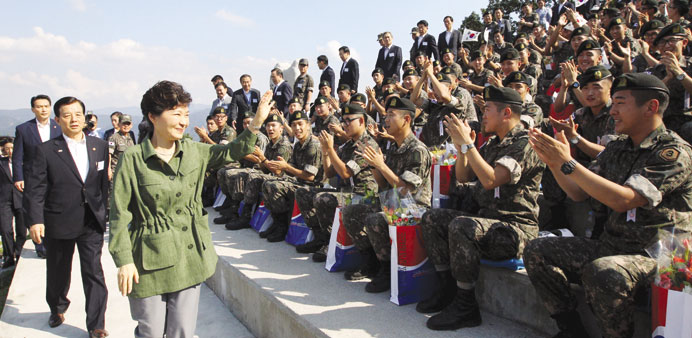South Korean President Park Geun-hye waves to soldiers after inspecting a US-South Korea joint live-fire military exercise at a training field near the demilitarised zone separating the two Koreas in Pocheon, South Korea, yesterday.
AFP/Seoul
South Korean and US troops staged their biggest-ever joint live-fire drill yesterday, including a simulated mechanised assault deep into North Korean territory, just days after the two Koreas ended a tense military standoff.
The exercise, conducted in several stages, envisaged an initial North Korean provocation, followed by an escalating clash, and culminating in a counter-attack across the border.
The drill was held near the border town of Pocheon, about 20km south of the demilitarised zone (DMZ), which splits the Korean peninsula between North and South.
“In terms of ammunition and personnel mobilised, this is the biggest live-fire exercise South Korean troops have ever staged independently or jointly with US troops,” a defence ministry spokesman told AFP.
It involved some 3,000 US and South Korean soldiers, around 100 tanks and armoured vehicles, 120 heavy guns, 45 helicopters and more than 40 jet fighters.
It followed a recent surge in cross-border military tensions that had pushed both Koreas to the brink of an armed conflict, before a negotiated deal to de-escalate was reached on Tuesday.
The drill opened with a simulated North Korean attack on a South Korean guard post.
The defence ministry’s original scenario had role-played an attack on South Korean loudspeakers blasting propaganda messages across the border, but it was revised after Tuesday’s agreement saw the South switch the speakers off.
The second stage of the exercise played out a North Korean raid across the heavily fortified border.
The final element was a counter-attack and simulated advance by South Korean and US mechanised units deep into North Korean territory to destroy missile facilities, command posts and other key facilities near Pyongyang.
The drill was played out in front of 2,000 guests including President Park Geun-Hye and senior US and South Korean military officials.
There are close to 30,000 US troops permanently stationed in South Korea.
Meanwhile, North Korean leader Kim Jong Un called this week’s accord between the rival Koreas “a landmark occasion” paving the way for defused military tension and improved ties, but said it was the strength of its armed forces that made the deal possible.
North and South Korea on Tuesday agreed to end a military standoff that sparked an exchange of artillery fire and had ratcheted up tension on one of the world’s most heavily-fortified borders.
The two sides also agreed to open a new channel of dialogue to discuss a range of issues with the aim of improving ties, raising hopes for a fresh push to restore talks and exchanges that had been cut off since 2010.
“The joint press release published at the contact provided a crucial landmark occasion of defusing the acute military tension and putting the catastrophic inter-Korean relations on the track of reconciliation and trust,” the North’s KCNA news agency on Friday quoted Kim as saying in a meeting with military aides.
Kim said the accord was reached “thanks to the tremendous military muscle with the nuclear deterrent for self-defence built by the great party as a pivot and matchless ranks single-mindedly united around the party,” KCNA said.
The comments were made at a meeting of the Central Military Commission of the North’s ruling Workers’ Party of Korea, the same forum led by Kim last week that warned of military action unless Seoul stopped its propaganda broadcasts.

